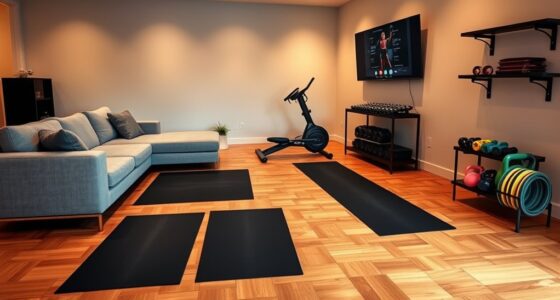In 2025, your lifestyle choices between minimalism and maximalism reflect your personality, values, and cultural influences. Minimalism helps you create calm, clutter-free spaces that boost mental clarity, while maximalism allows you to express creativity with bold patterns and vibrant colors. Both styles shape how you connect with your environment and well-being. Understanding how to balance simplicity with vibrancy can help you craft a space that truly resonates—you’re about to uncover more.
Key Takeaways
- Both styles reflect personal identity; minimalism promotes tranquility, while maximalism emphasizes self-expression and vibrancy.
- In 2025, blending minimalism and maximalism offers balanced, personalized environments tailored to individual preferences.
- Digital connectivity and sustainability influence lifestyle choices, encouraging mindful consumption and eco-friendly living.
- Minimalism reduces stress and clutter, whereas maximalism fosters creativity and confidence through expressive decor.
- Practical strategies include focusing on quality over quantity, decluttering, and customizing spaces to align with evolving values.
Defining the Core Principles of Minimalism and Maximalism
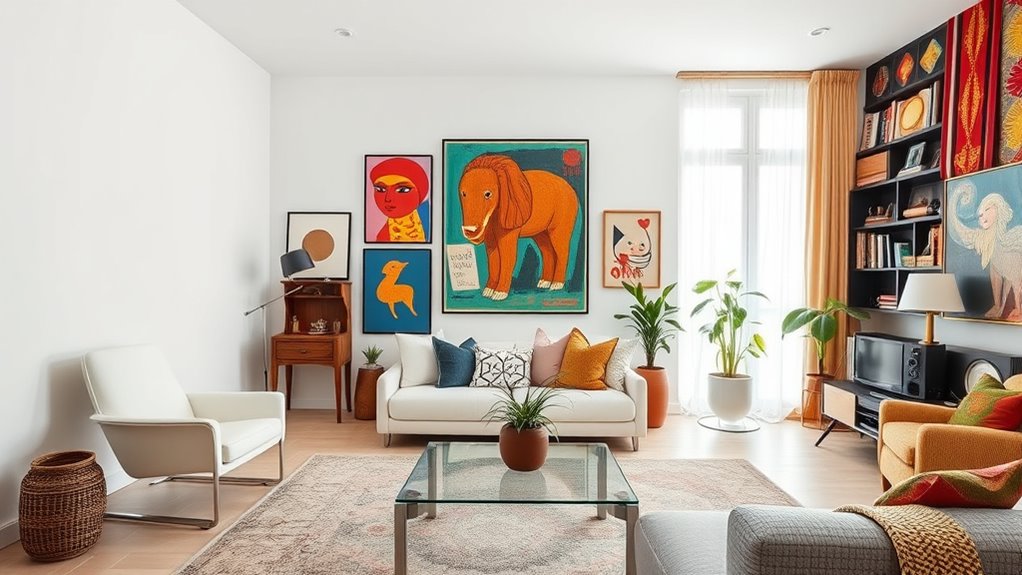
Minimalism and maximalism represent two contrasting design philosophies that shape how spaces and objects are perceived. Minimalism emphasizes aesthetic simplicity, focusing on clean lines, open spaces, and a clutter-free environment. It aims to create a calm, orderly atmosphere that highlights only what’s essential. Additionally, minimalism can influence personal well-being by reducing visual distractions and promoting mental clarity. The use of natural materials such as wood and linen can further enhance a minimalist space by adding warmth without clutter. Recognizing the importance of design harmony helps in creating environments that feel both balanced and intentional. Incorporating sustainable practices into minimalism can further align with eco-friendly values by reducing excess consumption and waste.
In contrast, maximalism celebrates expressive excess, layering bold colors, patterns, and diverse textures to evoke emotion and personality. It thrives on visual richness and complexity, often featuring numerous decorative elements. Both philosophies serve different tastes and intentions: minimalism seeks serenity through restraint, while maximalism invites excitement through abundance. Understanding these core principles helps you see how each style influences not just aesthetics but also how you experience your environment daily. Additionally, ethical hacking principles highlight the importance of assessing vulnerabilities and implementing security measures, which can be metaphorically compared to balancing simplicity and complexity in design to achieve harmony and safety.
The Cultural and Social Influences Shaping Lifestyle Trends in 2025

In 2025, your lifestyle choices are heavily influenced by digital social connectivity, shaping how you share and consume culture. Sustainability movements push you toward more mindful consumption and eco-friendly habits. Meanwhile, global cultural exchange broadens your perspectives, blending traditions and ideas into your everyday life. Embracing mindful decluttering can also help reduce material excess and promote sustainable living. Additionally, understanding cultural intelligence becomes increasingly important for navigating the diverse social and cultural influences shaping your lifestyle. Developing digital literacy is essential for effectively engaging with worldwide cultural trends and sustainability initiatives. Staying informed about environmental impacts of various lifestyle choices allows you to make more conscious decisions that align with a sustainable future.
Digital Social Connectivity
As digital social connectivity continues to evolve, it profoundly influences how people interact and form communities in 2025. You’re more aware than ever of the importance of balancing online presence with a digital detox, taking breaks to disconnect and recharge.
Online privacy remains a top concern, prompting you to choose platforms that prioritize security and control over your data. Social networks now emphasize authentic connections over superficial interactions, fostering deeper engagement.
You might curate your digital environment carefully, avoiding overstimulation and information overload. This shift reflects a desire for meaningful relationships amid constant connectivity. Additionally, understanding the privacy policy of electronic devices like heated mattress pads can help ensure a safe and comfortable sleep environment in your digitally connected lifestyle. Recognizing the impact of contrast ratio on image quality can also influence your choices when creating a cozy, visually appealing home space. Moreover, being mindful of networking solutions can enhance your digital infrastructure at home, supporting seamless connectivity for work and leisure. Incorporating wall organization systems can further optimize your living space, reducing clutter and promoting a harmonious environment that aligns with your digital lifestyle.
Sustainability Movements Rise
Digital social connectivity has made you more conscious of how your lifestyle impacts the environment, prompting a surge in sustainability movements in 2025. You’re adopting eco-friendly practices like reducing waste, choosing sustainable materials, and supporting local, ethical brands. Ethical consumption guides your purchasing decisions, ensuring products are made responsibly. This shift isn’t just individual; communities embrace collective efforts, pushing businesses and policymakers toward greener solutions. Here’s how these trends are shaping lifestyles:
| Eco-Friendly Practices | Ethical Consumption |
|---|---|
| Using reusable bags and containers | Supporting fair-trade products |
| Buying secondhand or vintage items | Favoring local and small businesses |
| Reducing energy use at home | Avoiding fast fashion |
| Composting and recycling | Ensuring transparency in sourcing |
| Choosing sustainable transportation | Prioritizing cruelty-free products |
Global Cultural Exchange
Have you noticed how global cultural exchange is transforming your lifestyle in 2025? Cultural hybridization is blending traditions, creating new, vibrant styles in fashion, food, and art. This dynamic process is supported by AI content clusters, which help curate and promote relevant cultural content across various platforms. Additionally, this blending often involves food fusion, inspiring innovative culinary experiences that reflect a mix of cultural influences.
You’re likely embracing artistic fusion, where diverse influences merge seamlessly, inspiring your personal choices. This exchange fuels a sense of interconnectedness, making your world more dynamic and inclusive. Whether you’re trying international cuisines or adopting design elements from different cultures, you’re part of a larger movement that breaks down barriers. As global ideas circulate more freely, your lifestyle reflects a rich tapestry of cultural influences, encouraging cultural hybridization to shape your personal environment. Furthermore, the rise of cultural exchange programs fosters deeper understanding and appreciation among diverse communities, enhancing these transformative trends.
This fusion encourages you to experiment and personalize your environment, embracing diversity without boundaries. In 2025, cultural hybridization and artistic fusion are shaping how you express yourself and connect with others worldwide. Resources and Tools
Practical Benefits and Challenges of Embracing Minimalism

Embracing minimalism can help you stay focused by reducing clutter and distractions. It also makes it easier to save money and adopt cost-effective living strategies. Additionally, incorporating sound design techniques such as ambient sounds and subtle effects can enhance your environment and personal spaces, promoting a calmer and more mindful lifestyle. Incorporating home organization strategies can further support your minimalism goals by creating streamlined, functional spaces that foster a sense of tranquility. Regularly assessing and identifying clutter ensures your space remains intentionally curated and aligned with your minimalism objectives.
Simplicity Enhances Focus
Simplicity sharpens your focus by reducing distractions and streamlining your environment. When clutter diminishes, your mind gains clarity, allowing you to concentrate on what truly matters. This mental clarity boosts productivity and decision-making, helping you avoid overwhelm. Embracing minimalism can be a challenge, but the benefits are clear. Consider the impact of clutter reduction versus a chaotic space:
| Clutter Reduction | Mental Clarity |
|---|---|
| Creates a calming environment | Enhances concentration |
| Saves time searching for items | Improves emotional well-being |
| Simplifies routines | Fosters creativity |
| Reduces stress | Promotes mindful living |
Focusing on simplicity not only declutters your space but also clears your mind, empowering you to navigate life with purpose.
Cost-Effective Living Strategies
By adopting minimalist living strategies, you can substantially reduce your expenses and make more mindful spending choices. Budget shopping becomes easier when you focus on quality over quantity, helping you avoid impulse buys and save money.
Embracing DIY home upgrades allows you to refresh your space without costly professional help, turning small projects into significant savings. Minimalism encourages you to declutter and prioritize essentials, which cuts down on unnecessary purchases and maintenance costs.
Additionally, choosing durable and low-maintenance shower fixtures can further decrease long-term repair and replacement expenses, aligning with cost-effective living principles. Being aware of the cost of electric bikes and related accessories can help you make smarter transportation investments that save money over time.
However, challenges include resisting societal pressures to acquire more and developing patience for DIY projects. While these strategies promote financial stability, they require discipline and planning.
Ultimately, embracing cost-effective living through budget shopping and DIY upgrades helps you build a sustainable, financially mindful lifestyle aligned with minimalist principles.
Emotional Well-being Impact
Adopting minimalist living strategies not only benefits your finances but also profoundly impacts your emotional well-being. Embracing minimalism can boost your emotional resilience by reducing clutter-induced stress and creating a calming environment. It helps you prioritize meaningful experiences over material possessions, positively influencing your mental health impact. Incorporating comfort and support solutions, such as simple, supportive furnishings, can further enhance your emotional stability. Comfort Solutions for Sofa Beds and other supportive elements can contribute to a more relaxed and stress-free living space. However, it also presents challenges like letting go of sentimental items or feeling deprived of possessions.
- Enhances clarity and reduces anxiety
- Fosters a sense of control and stability
- Encourages mindfulness and intentional living
- Minimizes overwhelm caused by excess
- Builds emotional resilience through simplicity
Expressing Identity Through Maximalist Aesthetics

Have you ever noticed how maximalist aesthetics serve as a bold canvas for expressing your unique identity? You can use color expression to showcase your personality, mixing vibrant hues and daring combinations that reflect your inner spirit.
Maximalism invites you to layer patterns, textures, and accessories, turning your space or wardrobe into a vivid extension of yourself. It’s an act of artistic expression, where every detail communicates your tastes, passions, and cultural influences.
Instead of blending in, you stand out by embracing boldness and complexity. This approach allows you to tell your story visually, making your environment or style a dynamic reflection of who you are.
Maximalist aesthetics empower you to communicate confidence and originality through a rich tapestry of design elements.
Finding Personal Balance: When to Simplify and When to Amplify
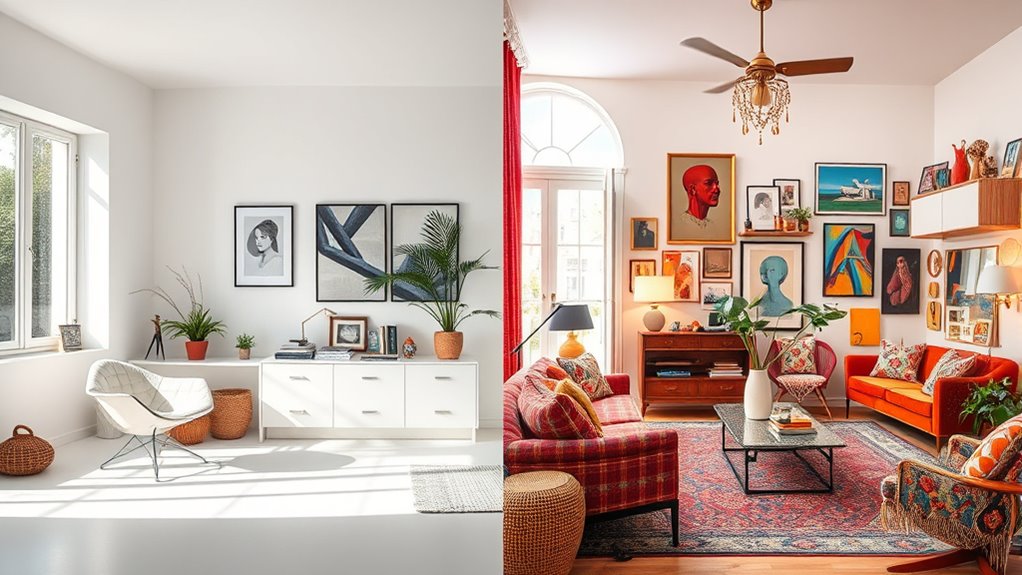
Finding your personal balance between simplicity and amplification requires awareness of your current needs and goals.
If you’re focused on personal growth, simplifying can help you stay grounded and clear-minded.
Conversely, amplifying your presence might boost your social influence and build confidence.
To find this balance:
- Assess your emotional and mental energy levels regularly
- Identify situations where minimalism enhances focus
- Recognize moments when maximalism sparks creativity and connection
- Adjust your environment to support your evolving priorities
- Reflect on how your choices impact your personal development and social interactions
Impact on Mental Well-being and Daily Living

Balancing minimalism and maximalism directly influences your mental well-being and daily routines. When you manage clutter effectively, it reduces stress and creates a sense of calm, making it easier to focus and stay organized.
Incorporating mindfulness practices helps you stay present, whether you’re decluttering or adding decorative elements. Minimalist spaces often promote clarity and relaxation, while maximalist environments can inspire creativity and energy.
However, too much clutter or excess can overwhelm your mind, leading to anxiety or fatigue. By consciously choosing how much to simplify or amplify, you support your mental health and streamline daily tasks.
Finding this balance allows you to enjoy a space that energizes you without becoming chaotic, ultimately enhancing your overall sense of well-being.
Integrating Both Approaches for a Unique Lifestyle
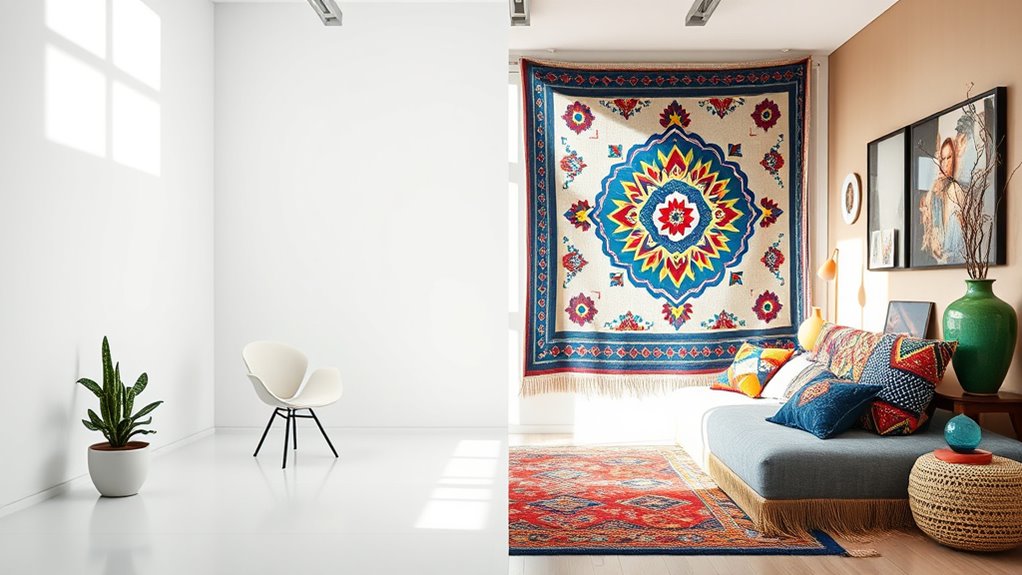
- Highlight favorite pieces or colors to add character
- Use clutter-free zones for calmness
- Incorporate statement art or decor for visual interest
- Mix simple furniture with vibrant accessories
- Personalize spaces with meaningful objects
This integration fosters a dynamic environment that’s both functional and expressive.
Future Perspectives: Evolving Trends in Minimalist and Maximalist Living
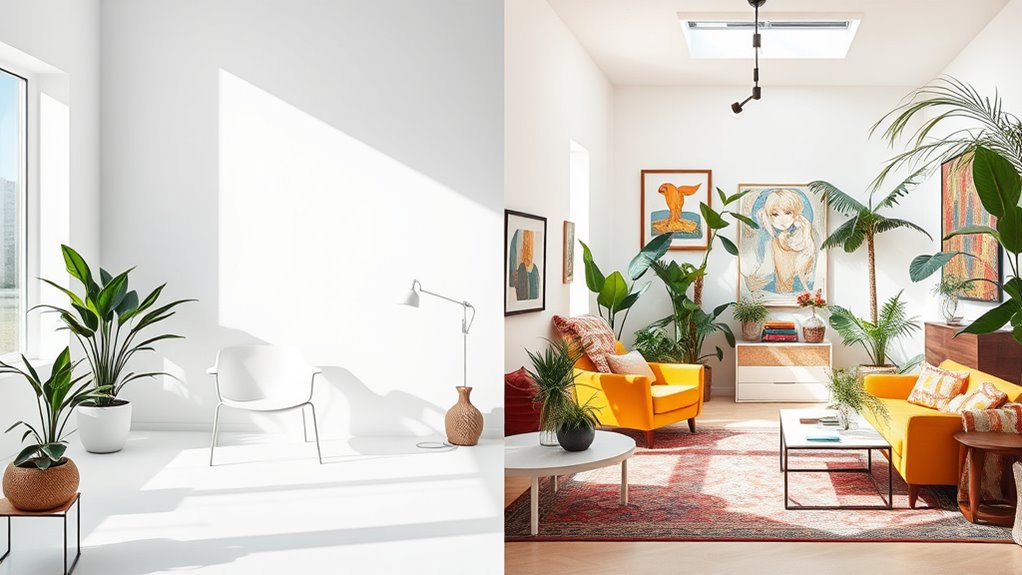
As design preferences continue to evolve, both minimalism and maximalism are embracing new trends that reflect changing lifestyles and values. In the future, you’ll notice a focus on aesthetic harmony, blending simplicity with bold statement pieces or subtle textures to create balanced spaces.
Minimalist design will continue to emphasize functional clarity, but with an increased appreciation for personalized touches that enhance creative expression.
Meanwhile, maximalism will push boundaries by integrating diverse patterns, colors, and layered elements to evoke vibrancy and personality.
Both styles will adapt to technological advances, incorporating smart features that support sustainable living and visual harmony.
Ultimately, these trends will empower you to craft environments that resonate with your identity, whether through understated elegance or exuberant creativity.
Frequently Asked Questions
How Do Minimalism and Maximalism Influence Personal Relationships?
Your lifestyle choices shape how you build personal relationships. Embracing minimalism fosters emotional intimacy through meaningful connections and clear social boundaries, making interactions more genuine.
Conversely, maximalism encourages vibrant, diverse relationships, but it can blur boundaries and overwhelm emotional space.
Can Blending Minimalism and Maximalism Create a Sustainable Lifestyle?
You can absolutely blend minimalism and maximalism to create a sustainable lifestyle, as long as you find the right balance and harmony. Think of it as having your cake and eating it too—this approach lets you enjoy the clean simplicity of minimalism while embracing vibrant, creative expression from maximalism.
What Role Does Technology Play in These Lifestyle Choices?
Technology shapes your lifestyle choices by offering tools like virtual reality for immersive experiences and promoting digital detox practices to reduce screen time.
These innovations help you find a balance between minimalism and maximalism, allowing you to declutter digital spaces or indulge in vivid virtual environments.
Embracing these technologies empowers you to customize your lifestyle, making intentional decisions that align with your personal preferences and sustainable habits.
How Do Economic Factors Impact the Popularity of Each Approach?
If the economy tightens, you might notice fewer luxury spending habits supporting maximalism, while minimalists could thrive by emphasizing savings and simplicity.
For example, during an economic downturn, a family might downsize their possessions and focus on essential needs, reflecting minimalism’s appeal.
Conversely, in a booming economy, maximalists might indulge in more luxury items, boosting their lifestyle.
Economic factors directly influence which approach feels more accessible or sustainable for you.
Are There Specific Age Groups More Inclined Toward Minimalism or Maximalism?
You’ll find that younger generations, like Millennials and Gen Z, tend to lean toward minimalism, valuing simplicity and sustainability.
Meanwhile, older age groups, such as Baby Boomers and Gen X, often favor maximalism, embracing more expressive and layered lifestyles.
These generational preferences reflect lifestyle demographics shaped by their unique experiences, priorities, and cultural influences, influencing their appeal toward either minimalism or maximalism in 2025.
Conclusion
As you navigate the delicate dance between minimalism and maximalism, remember that your lifestyle is a canvas waiting for your unique brushstrokes. Whether you choose the quiet serenity of simplicity or the vibrant chaos of abundance, trust your instincts to create harmony. In this evolving landscape, balance isn’t just a goal—it’s your compass, guiding you through the colorful tapestry of life, where every choice paints the masterpiece of your authentic self.


